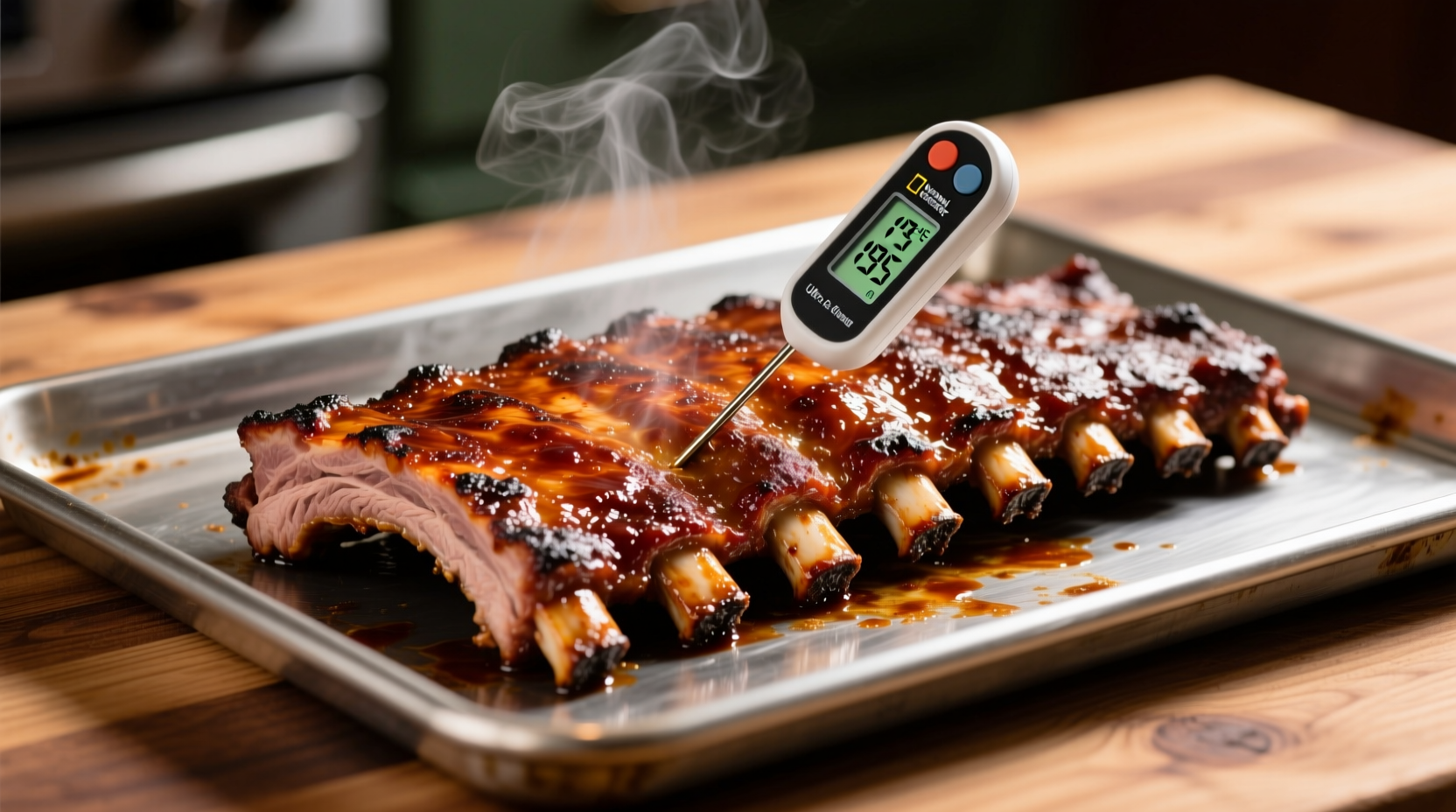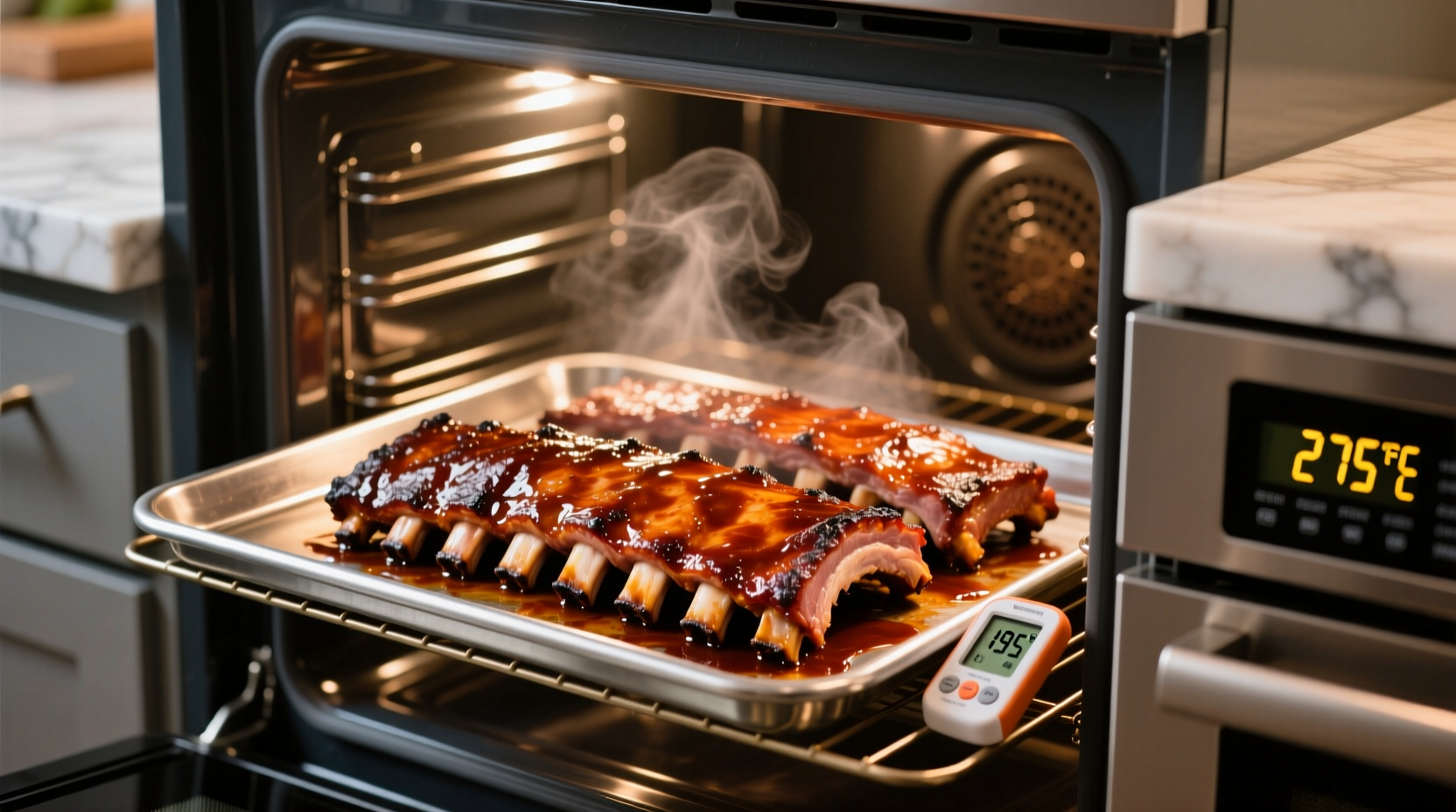Ever pulled oven-cooked ribs from the rack only to find them tough, dry, or undercooked? You're not alone. Getting the temperature right transforms ribs from disappointing to delectable. This guide reveals the precise science-backed methods professional chefs use to achieve fall-off-the-bone perfection every time.
The Temperature Science Behind Perfect Oven Ribs
Cooking ribs isn't just about setting your oven dial—it's about understanding how temperature affects collagen breakdown and moisture retention. Unlike steak or chicken, ribs contain substantial connective tissue that requires specific thermal conditions to transform into tender, juicy meat.
| Oven Temperature | Collagen Breakdown | Moisture Retention | Recommended For |
|---|---|---|---|
| 225°F (107°C) | Excellent (slow breakdown) | Optimal (minimal moisture loss) | Spare ribs, competition-style |
| 250°F (121°C) | Ideal (balanced breakdown) | Excellent (controlled evaporation) | All rib types, home cooking |
| 275°F (135°C) | Good (faster breakdown) | Good (some moisture loss) | Time-constrained cooking |
| 300°F+ (149°C+) | Poor (incomplete breakdown) | Poor (significant drying) | Avoid for ribs |
According to the USDA Food Safety and Inspection Service, pork should reach a minimum internal temperature of 145°F for safety. However, ribs require much higher temperatures—195-203°F—to properly break down collagen into gelatin. This scientific principle, documented in Harold McGee's On Food and Cooking, explains why low-and-slow cooking produces superior results.
Your Step-by-Step Oven Rib Cooking Process
Preparation: Setting Up for Success
Before touching your oven dial, properly prepare your ribs:
- Remove the membrane from the bone side using a butter knife and paper towel for better seasoning penetration
- Apply a thin layer of mustard (acts as binder) followed by your dry rub
- Let ribs rest uncovered in the refrigerator for 1-2 hours to develop flavor
Temperature Selection: Matching Method to Rib Type
Not all ribs cook the same. Adjust your oven temperature based on rib variety:
- Baby back ribs: 250°F for 3-4 hours (more tender, less fat)
- Spare ribs: 225-250°F for 4-5 hours (higher fat content requires longer)
- St. Louis style: 250°F for 3.5-4.5 hours (trimmed spare ribs)
Professional pitmaster Myron Mixon, featured in Smokin' with Myron Mixon, emphasizes that "temperature consistency matters more than absolute precision. A stable 250°F environment produces better results than fluctuating between 225-275°F."
Cooking Process: The Critical First Hours
Place ribs bone-side down on a wire rack positioned over a baking sheet with water. This creates a gentle steam environment while allowing airflow. After 2 hours:
- Check internal temperature (should be around 150°F)
- Optional: Wrap in foil with apple juice for "the Texas crutch" method
- Continue cooking until internal temperature reaches 195-203°F

Doneness Testing: Beyond Temperature Readings
While thermometer readings are essential, use these additional doneness indicators:
- Bend test: Lift ribs with tongs—they should bend easily and cracks appear in the surface
- Meat retraction: Bones should protrude slightly (1/4 inch) from the end
- Fork test: Meat should separate easily but not fall completely off the bone
Avoiding Common Rib Cooking Mistakes
Even with perfect temperature settings, these errors can ruin your ribs:
Opening the Oven Too Frequently
Every time you open the oven door, temperature drops 25-50°F and takes 5-10 minutes to recover. Use your oven light and window instead. As the National Pork Board confirms, "consistent temperature is critical for proper collagen breakdown in pork ribs."
Skipping the Resting Period
Remove ribs from oven at 200°F and let rest 15-20 minutes wrapped in foil. This allows juices to redistribute. Cutting too soon releases precious moisture onto your cutting board rather than staying in the meat.
Confusing Oven Temperature with Internal Temperature
Many home cooks mistakenly think ribs are done when oven reaches 195°F rather than the meat itself. Always use an instant-read thermometer inserted between bones for accuracy. The USDA Food Safety and Inspection Service emphasizes that "relying on cooking time alone is unreliable for determining doneness."
Troubleshooting Your Oven Ribs
Ribs Cooking Too Slowly
If your ribs aren't reaching target internal temperature:
- Verify oven calibration with a separate oven thermometer (many home ovens run 25°F hot or cold)
- Move ribs to a lower rack position (heat rises in ovens)
- Consider wrapping in foil to accelerate cooking
Ribs Drying Out
Excessive dryness usually indicates:
- Temperature too high (above 275°F)
- Cooking time too long
- Insufficient moisture in cooking environment
Solution: Lower temperature by 25°F, add water to baking sheet, and wrap in foil for remaining cooking time.
Pro Tips for Next-Level Oven Ribs
- Reverse sear method: Cook low-and-slow first, then finish at 400°F for 10-15 minutes for caramelized exterior
- Smoke infusion: Add 1/2 cup wood chips to aluminum foil packet on oven floor for subtle smokiness
- Temperature zones: Create a two-zone oven by placing ribs away from direct heat source
Remember that oven performance varies significantly by model. As culinary researcher Shirley Corriher notes in BakeWise, "Oven thermometers frequently differ from actual oven temperatures by 50°F or more. Always verify with an independent thermometer."
Frequently Asked Questions
What is the lowest temperature you can cook ribs in the oven?
The lowest effective temperature for oven-cooked ribs is 225°F. Below this temperature, collagen breakdown occurs too slowly, increasing food safety risks during extended cooking times. The USDA Food Safety and Inspection Service recommends maintaining cooking temperatures above 140°F to prevent bacterial growth.
Can you cook ribs at 350 degrees in the oven?
While possible, 350°F is generally too high for optimal rib results. At this temperature, exterior meat dries out before connective tissues fully break down. If using higher heat, limit cooking time to 1.5-2 hours and wrap ribs in foil with liquid to retain moisture. The National Pork Board advises that "higher temperatures produce less tender results due to rapid moisture loss."
How do you know when ribs are done in the oven without a thermometer?
Without a thermometer, use the bend test: lift ribs with tongs at one end—they should bend easily and form a U-shape with surface cracks appearing. Meat should pull back slightly from bones (about 1/4 inch), and a fork should slide between bones with moderate resistance. However, the USDA strongly recommends using a food thermometer for food safety.
Should ribs be covered when cooking in the oven?
Initially, cook ribs uncovered for better bark formation. After 2 hours or when internal temperature reaches 150°F, many chefs recommend wrapping in foil (the Texas crutch method) to accelerate collagen breakdown. If using barbecue sauce, apply during the final 30 minutes uncovered to prevent burning. The National Pork Board confirms that "wrapping midway through cooking helps achieve optimal tenderness while maintaining moisture."
Why are my oven ribs tough?
Tough ribs typically result from insufficient cooking time or temperature too low to properly break down collagen. Ribs must reach 195-203°F internally for connective tissues to transform into gelatin. Other causes include removing membrane (which protects moisture), cooking at too high temperature causing rapid moisture loss, or skipping the essential resting period before serving.











 浙公网安备
33010002000092号
浙公网安备
33010002000092号 浙B2-20120091-4
浙B2-20120091-4